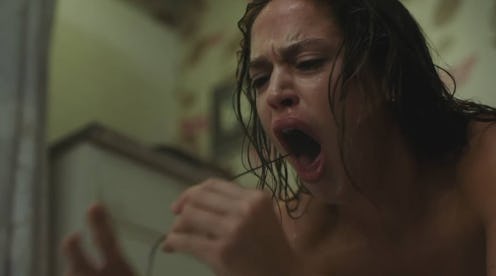
You know the gist of the story. Someone tells you about a strange video that no one can seem to make sense of. You watch it, cringing at the grotesque and scattered content. When it ends and you're still staring at the static, the phone rings, and a child's voice tells you that you'll die in seven days. It's the curse that's driven the story for three English-language psychological horror films so far, beginning with 2002's The Ring. But the new installment of the series changes the rules completely. The ending of Rings is a twist that could set up a new era for the franchise. Spoilers ahead!
In the first American adaptation of the Japanese original, Rachel, a reporter played by Naomi Watts, discovers the story behind the tape and the spirit it seems to embody. It's an iconic image in modern horror that closes out The Ring: murdered psychopath Samara Morgan crawls spider-like out of the well she was left in as a child and through a TV screen to reach her victim. A sequence like that has diminishing returns. The more times it's repeated, the less impact it has. For the franchise to keep going, it's necessary to throw some curveballs at the audience.
You know you're really in for it when a horror movie seems to follow a relatively happy resolution with a throwaway scene. That's when the twist occurs in Rings. Leads Julia (Matilda Lutz) and Holt (Alex Roe) are back from their sojourn to Samara's birth place. They unknowingly picked up where Watts' character left off after The Ring and The Ring 2 in filling out the girl's biography. She was killed by her adoptive mother, yes, but what wasn't known until the third film is that she was the product of an abusive relationship. The town priest (Vincent D'Onofrio) kidnapped Samara's birth mother and imprisoned her inside the church. Later, he dug up his own daughter's remains as revenge for the way she tortured him.
Julia's relationship with Samara seems different to her other potential victims, though the tape has always been a form of posthumous communication. But when Julia watches the video, she sees different images than the rest. It' a trail, and the girl is calling to her. Samara has marked her; Julia believes that Samara wanted her to find the girl's monstrous father and get justice. But she's wrong.
Before he's killed, Holt's professor (Johnny Galecki) who was studying the video figures out that a mysterious burn on Julia's hand is actually braille. (It's the only way Samara can send a message to her father, who blinded himself to avoid her wrath.) While Julia showers, Holt listens to the voicemail and translates the language. The word is "rebirth." In the bathroom, Julia begins to retch up clumps of Samara's dark, lank hair. The last shot of Rings is Samara's corpse standing where Julia just was, looking at herself in Holt's bathroom mirror.
Samara has possessed humans before. She took over the body of Rachel's son in the second film. But it was for a limited amount of time. Now, Samara is back in the land of the living and not trapped in the cursed tape. It's a twist that gives the series a much-needed reboot. Now, Samara is a vengeful ghost with psychic powers and unlimited mobility. A sequel could take this character in any number of directions.
Rings doubles-back on some territory already covered by the first two movies. But if a future film can re-imagine Samara as a different type of spectral threat, then the rehash will have been worth it.